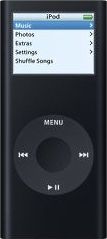Dos and Don'ts for Beating the iPod (and iTunes)
Lots of people in both the music/media and technology businesses are obsessed with beating Apple’s work on the iPod and iTunes. With the CES show being this week, that obsession will reach its annual peak, so I figured I’d take the time to post a list I’d made some time ago. Herewith, a list of the key dos and don’ts for beating Apple’s iPod and iTunes, in no particular order.

Do: Be Rock and Roll. Have an attitude, be All About The Music, and express yourself. Now, that doesn’t mean you have to have faux-edgy marketing copy for your service or device, but just that you should make decisions for your products based on what a music fan would want.
Don’t: Try to teach kids about DRM. Now, if and when iTunes eventually loses in the market, it will be because of DRM. And you can get significant advantages by just embracing unprotected MP3s, since that’s what most people want and they work with everything. But the thing is, DRM is boring. Teaching consumers about DRM is like giving your cat a bath: You’re only going to piss her off, and she’d do a better job of it on her own anyway. Explain your lack of DRM in terms of user benefits instead of technology, and you’ll avoid disgruntled customer testimonials.
Do: Make something that breaks in, instead of breaking down. The iPod’s greatest flaw is that it’s designed to inspire reverence and requires being coddled. Remember being rock and roll? Rock is about leather and denim, which wear with time and get more personality as they’re used. Kind of like a good guitar. And being able to drop an MP3 player in a crowded high school cafeteria without everyone laughing that your expensive device is destroyed is a killer app.
Don’t: Forget about the rest of the world. The iTunes store neglected most countries in the world for most of its history, and is only just starting to remedy the problem years later. And the store’s library offers an abysmal selection of international songs. Even here in the U.S., one quarter of Americans are either immigrants or have an immigrant family member, which connects them to the international community. Their music and videos are pretty much invisible in Apple’s world — sounds like an opportunity to me.
Do: Let people make their own music. Apple lets people make music with GarageBand, and lets people buy music with iTunes, but doesn’t let people sell or distribute their own songs. That means companies who make music-making tools ranging from Acid to ProTools don’t have an easy venue to get their music in front of an audience. And most of them don’t want to make money, they just want people to hear their songs. “I can get my boyfriend’s band’s music” is a great way to combat an iTunes exclusive track.
Don’t: Try to fit in. Everyone’s gone from making super-ugly MP3 players to coming as close to cloning the iPod as possible without getting sued. What about headphones with an LED built in, if you’re insistent on calling attention to yourself? What about wireless headphones, to neutralize the cool factor of the white cord in the iPod ads? And why aren’t you selling “the music player for the rest of us”? Now that the iPod is downright ubiquitous, you can play up the subversive angle of not wearing the white earphones: Trying not to wear the same thing as everyone else is exactly what rock and roll is about. Tell kids they deserve a music player as unique as they are, and remind everyone that white is the color of sheep.
Do: Make friends with Radio and TV. No, no, not in the old-fashioned Clear Channel way. For this audience, XM, Sirius, Netflix and Tivo define radio and television, and that content should be natively made part of their experience. Not just that I can copy a show from my Tivo to my device, but that my XM account is integrated and automatically syncing up to my player. A discount on the songs that I’ve listened to on Sirius radio. In short, a real connection to the other media I’m consuming.
** Don’t: Forget about the geeks.** Hackers will make the features that aren’t economical for you to create, that are too far-out for you to think of, and that are so personal and unique that they really draw people into forming a personal connection with your product or service. Right now, the iPod tries desperately to block any creative hacking that people do with the device. Sure, there’s no mass market for a Beowulf cluster powered by MP3 players, but there may be a lucrative long tail of buyers who want little applets or hardware hacks for the hard drives they’re carrying around everywhere.
Do: Invest in the experience. The thing Apple has shown with the iPod’s success is that people are willing to spend a premium for a good experience, even at the expense of features, freedom, or flexibility. If you can offer a distinctive experience that exceeds what Apple can do in any of these regards, there’s the potential for a big win. Creative wasted millions on a misbegotten campaign to have their Zen players take on the iPod, but for the $300 million dollars they blew on billboards or bus stop ads, they could have paid Kanye or Coldplay to play a gig in the living room of some music fan. People want a connection to the music and musicians they care about, and they want to take part in experiences that are beyond the reach of their connections or wallets. Give them the chance to really meet (or be) a rock star, and you’ll have something better than just another MP3 player.